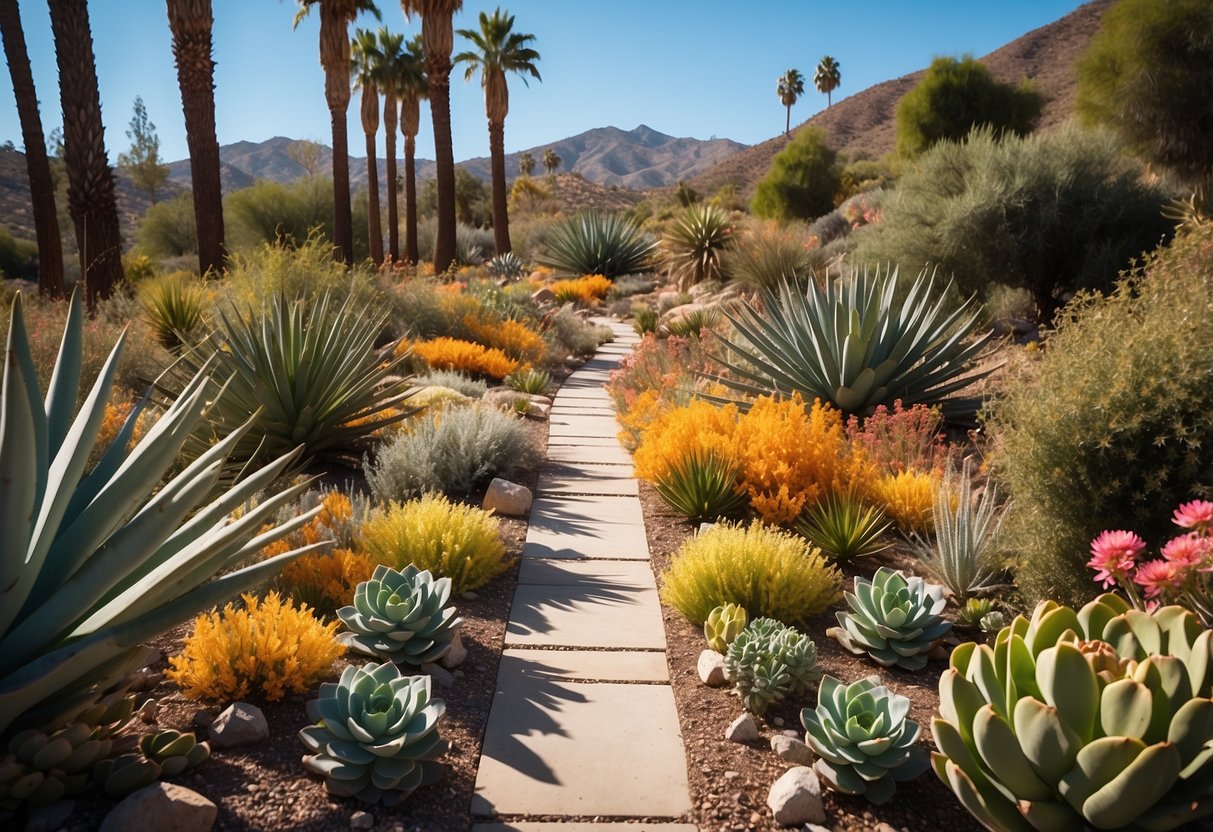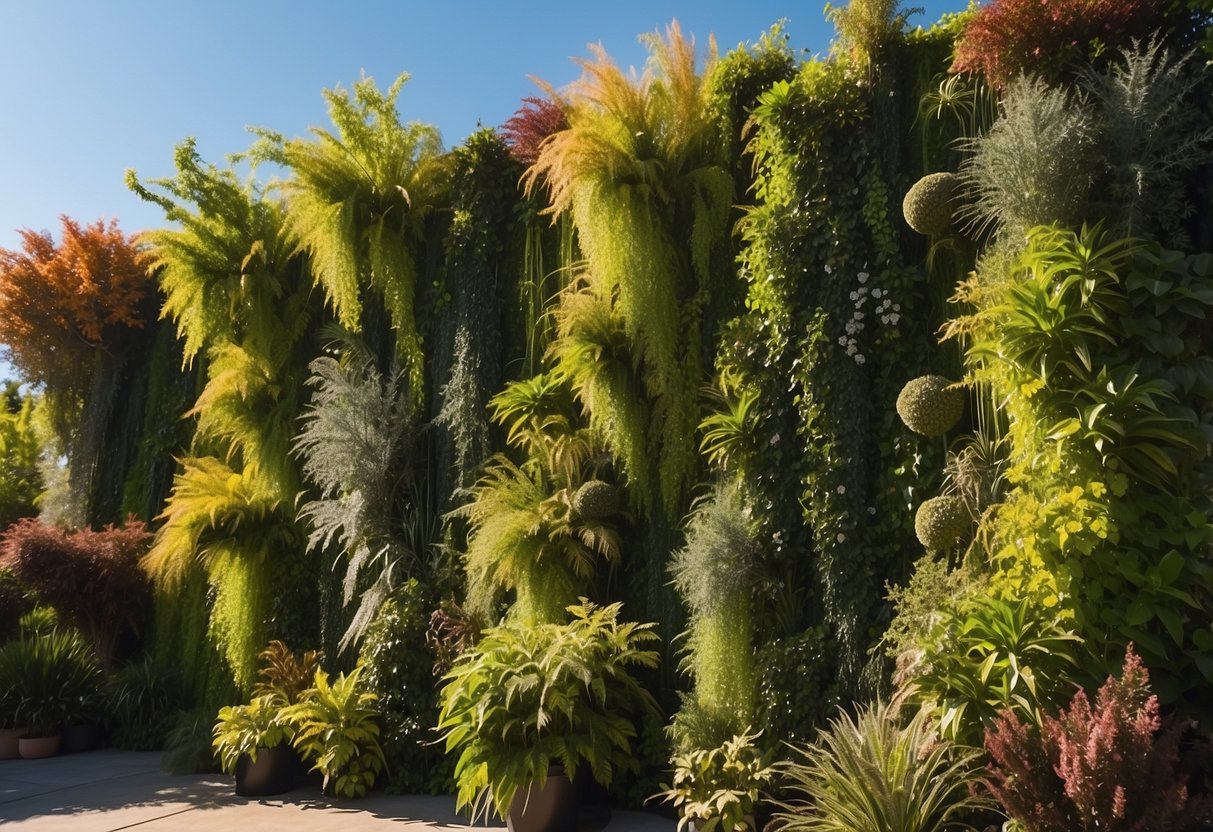California Garden Ideas: Transform Your Backyard into an Oasis
Gardening in California offers unique opportunities due to its diverse climate and landscapes. Whether you’re working with a small urban space or a sprawling backyard, there are countless ways to create a beautiful and sustainable garden that thrives in the Californian environment.

What are the best California garden ideas to help you make the most of your space? From drought-tolerant plants to innovative landscaping designs, blending beauty and practicality becomes easy and enjoyable. Get ready to explore inspiring ideas to transform your garden into a stunning oasis year-round.
1) Succulents Arrangement

Succulents are perfect for a California garden. They can survive heat and dry conditions, making them a low-maintenance choice.
You can plant succulents in many creative containers. Try using a rotted tree trunk or an upcycled cheese box for a unique look. These arrangements add charm to your garden and are great for small spaces.
Don’t forget to ensure good drainage by drilling holes in your containers. This will help your succulents thrive. Check out more ideas for succulent containers at Epic Gardening and BHG.
2) Mediterranean Herb Garden

Creating a Mediterranean herb garden in California is a fun and rewarding project. Start by planting popular herbs such as basil, rosemary, thyme, oregano, and sage. These herbs thrive in the warm, sunny climate of California.
For the best results, make sure to plant your herbs in well-draining soil. It’s important to give them plenty of sunlight and water them regularly during dry periods. You can also use containers if space is limited.
These fragrant herbs can be used in a variety of dishes, adding vibrant flavors to your cooking.
3) Tropical Foliage Corner

Create a lush escape in your backyard with a Tropical Foliage Corner. Select plants with big, bold leaves like elephant ears and banana plants. These plants provide a vibrant, jungle-like atmosphere.
Don’t forget to add some shade-loving plants such as ferns and hostas. They thrive under taller plants or pergolas. This mix will replicate the dappled shade found in tropical rainforests.
Accessorize with whimsical elements like seashells or a small fountain to enhance the tropical feel. Adding a metal sea turtle or vintage boat planter can also bring extra charm to your tropical corner.
4) Zen Rock Garden

Creating a Zen rock garden in your California yard can bring a sense of peace and calm. Choose simple elements like gravel and stones to form patterns and shapes.
Add a small water feature with pebbles around it for a soothing touch. Water sounds can enhance the tranquil feel.
Opt for drought-resistant plants like succulents or conifers. They thrive in California’s climate.
5) Raised Vegetable Beds

Raised vegetable beds are perfect for growing your favorite veggies in your California garden. They help improve soil drainage, which is crucial in areas with heavy clay soil. You can also control the soil quality better, ensuring your plants get all the nutrients they need.
Adding raised beds can make gardening easier on your back because you won’t have to bend down as much. They also help keep pests, like snails and slugs, at bay. You can even use materials like wood, stone, or metal to match your garden’s style.
For inspiration, check out these raised bed garden layout plans or explore some creative design ideas. Raised beds not only look great but also keep your vegetable garden organized and efficient.
6) Butterfly Garden

Creating a butterfly garden in California can be rewarding and beautiful. To attract butterflies, you need a sunny spot. Butterflies are cold-blooded and rely on the sun to keep their bodies warm.
Plant native species such as California coffeeberry, California lilac, and holly leaf cherry. These plants provide both nectar and places for butterflies to lay their eggs.
Make sure your garden is sheltered from strong winds. Butterflies need a calm environment to flutter around and feed. For more ideas, check out this guide to gardening for butterflies.
7) Fruit Trees Orchard

Creating a fruit trees orchard in your California garden is a rewarding project. Fall and early winter are the best times to plant because the warm soil helps the roots grow.
Most fruit trees need 6-8 hours of sunlight each day. Make sure you pick a sunny spot in your garden.
Consider different types of fruit trees like nectarine or fig trees. They are beginner-friendly and can thrive in California’s climate.
8) Vertical Garden Wall

A vertical garden wall is a great way to bring life to smaller spaces. You can use a variety of planters and mount them on a wall or fence.
One option is to create a slat wall with planters. This helps to add greenery and save space at the same time.
Another idea is to build a succulent wall garden. Succulents need little water, making them perfect for low-maintenance gardens.
9) Hummingbird Haven

Creating a spot for hummingbirds in your California garden can bring a lot of joy. Start with colorful plants like Heuchera sanguineum ‘Delta Dawn’ which bloom in early summer. These plants attract hummingbirds and can brighten the shadier parts of your garden.
You can also use vines like the Black-eyed Susan Vine. They not only attract hummingbirds but add a vibrant touch to your yard. A small fountain or mister can keep these birds coming back by providing fresh, moving water. Enjoy watching them hover and zip around your garden!
10) California Native Plants

Adding California native plants to your garden can bring beauty and support local wildlife. Plants like sages, monkeyflower, and buckwheat attract bees, hummingbirds, and butterflies to your outdoor space.
For a pop of color, consider planting California Fuchsia. Its red-orange blooms light up the garden in the fall. It’s also a favorite of hummingbirds.
If you have tough spots, like curbsides, try resilient grasses and annually seeded flowers. Even small spaces like patios or balconies can become native plant oases with the right containers. Explore more at California Native Plant Garden Style.
Essential Elements for a California Garden

Creating a stunning California garden involves selecting drought-resistant plants, maintaining soil health with mulching, and installing efficient irrigation systems. These elements ensure a vibrant garden that is both eco-friendly and easy to manage.
Drought-Resistant Plants
In California, using drought-resistant plants helps conserve water and lowers maintenance. Plants like the California Poppy and the San Diego Monkeyflower are perfect choices. These plants not only survive with minimal watering but also bring vibrant colors to your garden.
Another great option is the California Lilac, known for its attractive blue flowers. Succulents are also popular due to their unique shapes and low water needs. By choosing these plants, your garden will look beautiful even during dry spells.
Mulching and Soil Health
Mulching is essential for maintaining soil health in your garden. Mulch helps retain moisture, which is crucial in a dry climate. It also prevents weeds from growing and adds nutrients to the soil as it decomposes.
Organic mulches such as wood chips or straw are excellent choices. They enrich the soil and improve its structure over time. Adding a layer of mulch around your plants not only keeps them healthy but also makes your garden more attractive.
Efficient Irrigation Systems
Efficient irrigation is key to a thriving California garden. Drip irrigation systems are ideal because they deliver water directly to the roots, reducing water waste. These systems can be easily adjusted to provide the right amount of water for each plant.
Using a timer for your irrigation system ensures your plants get watered at the best times of the day, usually early morning or late evening, to minimize evaporation. Smart irrigation controllers can further optimize water use by adjusting the schedule based on weather conditions.
Using efficient systems conserves water and keeps your garden green and flourishing.
Designing Your California Garden

Designing a garden in California offers unique opportunities to embrace the region’s natural beauty and diverse plant life. Focus on creating colorful landscapes, incorporating native plants, and adding functional spaces to enhance your garden.
Creating Colorful Landscapes
Use a variety of plants that thrive in the California climate to create vibrant and colorful landscapes. Succulents and native wildflowers, such as California poppies and lupines, are excellent choices. These plants not only add stunning colors but are also drought-tolerant and easy to care for.
Consider planting in layers, with ground covers, mid-height plants, and taller shrubs or trees, to create depth and interest. Bold color blocks can make a striking visual impact, while mixing different textures and leaf shapes can add complexity and charm. Water-wise gardening techniques can help maintain colors even during dry seasons.
Incorporating Native Plants
Choosing locally native species is one of the best ways to ensure your garden thrives. Native plants are adapted to the local climate and soil, making them more resilient and low-maintenance. They also support local wildlife, including birds, butterflies, and bees.
Use resources like the California Native Plant Society to find plants that are perfect for your area. Examples include manzanitas, ceanothus, and perennials like salvias. Place plants where they are most likely to flourish, considering factors like sunlight, shade, and water availability.
Adding Functional Spaces
Incorporate functional spaces to make your garden more enjoyable and practical. Adding features like patios, paths, and seating areas can turn your garden into an outdoor living space. Use natural materials such as stone or wood to blend seamlessly with the environment.
Think about installing a small water feature like a bird bath or a fountain, which can attract wildlife and provide a calming ambiance. Raised garden beds or container gardens can be useful for growing herbs and vegetables, making your garden both beautiful and productive.
Integrating these elements thoughtfully will help create a garden that is not only visually appealing but also functional and environmentally friendly.







